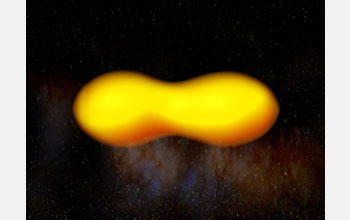Binary Star System
By: Jenny Wu

What is the binary star system?
More than half the stars in the universe can be found in binary star systems. The term binary star system refers to the phenomena in which two stars are tied together because of their orbiting patterns. The binary stars in this system are associated with each other because they orbit around a common center of mass. Because the stars are different sizes and shapes, they have different orbits that are relative to their masses. However, the orbits of binary stars tend to lie on a single plane.
Types of Binary Systems:
Visual Binary – In a visual binary system, the two stars can be seen separately and distinctly through a telescope. In order for this system to exist, the stars must have large orbits, so that they do not blend together through a telescope and can, in fact, be seen as two entities in the sky. If the orbits are too small, due to enormous distance between Earth and the two respective stars, their images will coalesce into a single point in the telescope. Usually, the visual binary stars have long orbital periods to accommodate their large orbits.
Physical Binary – This is when two stars are actually orbiting each other.
Optical Binary – This is when the stars appear close together when they are actually very far apart and not bound together by gravity.

Spectroscopic Binary – In a spectroscopic binary system, the stars appear as one entity, even when viewed through a telescope. Usually, they are this way because they are in close proximity to each other or are orbiting very rapidly. The only ways to know that they are two distinct stars is by utilizing the Doppler Effect or by looking at a spectrum formed by the stars’ spectral lines. When observing the spectrum, an oscillation, otherwise known as an anomaly, will be present due to the fact that the stars are moving and do not possess the same spectral lines. Strangely, it is possible for the system to be both visual and spectroscopic if the spectroscopic binary stars are far apart from each other and an extremely high resolution telescope is used. Most binary stars are in a spectroscopic binary system.
Eclipsing Binary – In an eclipsing binary system, because the stars’ orbits lie in a single plane, the stars are seem as crossing each others’ paths and eclipsing each other from our view. In this system, our perspective of the stars is only from the “edge” of the plane of their orbits. Therefore, observers from Earth will see them moving back and forth across each other in a straight line. From Earth’s perspective, the stars will take turns eclipsing each other. Whenever this happens, the overall magnitude of the brightness of the system will decrease. The smaller star eclipsing the larger star will result in a smaller decrease than the larger star eclipsing the smaller star. This variation in brightness produces the light curve, which is a graph of brightness versus time.

Astrometric Binary – In an astrometric binary system, only one star is visible. The existence of the other star is deduced from the noticeable wobble in the orbit of the visible star. This wobble is the product of the gravitational influence of the smaller star on the larger, visible star.

What is the importance of the binary star system?
The binary star system is important in that it allows astrophysicists to calculate the masses of the individual stars in the system. They use the following equation to determine the masses of the stars:
MA + MB = a3 / p2
This equation reveals that the masses, average distances to each other, and orbital periods are all related to one another. The ratio between the radii, or the distance to the center of mass, of the two stars is equal to the ratio between the masses of the two stars. The closer the star’s orbit to the center of mass, the larger the mass is.
Interesting News:
- A mere 8, 000 light years from Earth is a very beautiful, but potentially deadly binary star system. This star system, located in the constellation of Sagittarius, contains the highly unstable star Wolf-Rayet, which is on the evolutionary step to supernova status. When the system explodes as a supernova, a highly focused dose of gamma rays will be emitted from the northern and southern poles of this system. Unfortunately for Earth, it is in the direct path of those gamma rays, evident by the fact that the system appears to us in a nearly perfect spiral, which is only possible if viewed form one of the poles.

- In 2003, the small, young star T Tauri was ejected from its binary star system. This was the result of the gravitational influence the neighboring stars had on the young star.
- In 2008, researchers discovered an extremely rare yellow super-giant eclipsing binary star system that, when viewed through a telescope, appears in the shape of a peanut. This system, one of only two of its kind discovered, contains two large stars of almost identical sizes. Before this discovery, astronomers did not believe that a star’s life could end in the in-between temperatures of a yellow star since the transition between the hot blue and the cool red is very short.

Sources:
Seeds, Michael A. Foundations of Astronomy: Eighth Edition
http://www.bbc.co.uk/dna/h2g2/A381124
http://www.universetoday.com/guide-to-space/stars/what-is-a-binary-star/
http://www.universetoday.com/2003/01/14/binary-star-ejected-from-its-system/
http://www.cosmosmagazine.com/node/1878
http://www.nsf.gov/news/news_summ.jsp?cntn_id=111349
http://www.cfa.harvard.edu/hea/osp/wdan.html
http://outreach.atnf.csiro.au/education/senior/astrophysics/binary_types.html
http://www.astroscience.org/abdul-ahad/binariasejemplo.jpg
http://www.physics.uc.edu/~hanson/ASTRO/LECTURENOTES/W02/Lec6/EclBinary_anim.gif
http://4engr.com/images/research/3eedbd5172d9129c7134061a4cc8724f.jpg
Comments (0)
You don't have permission to comment on this page.